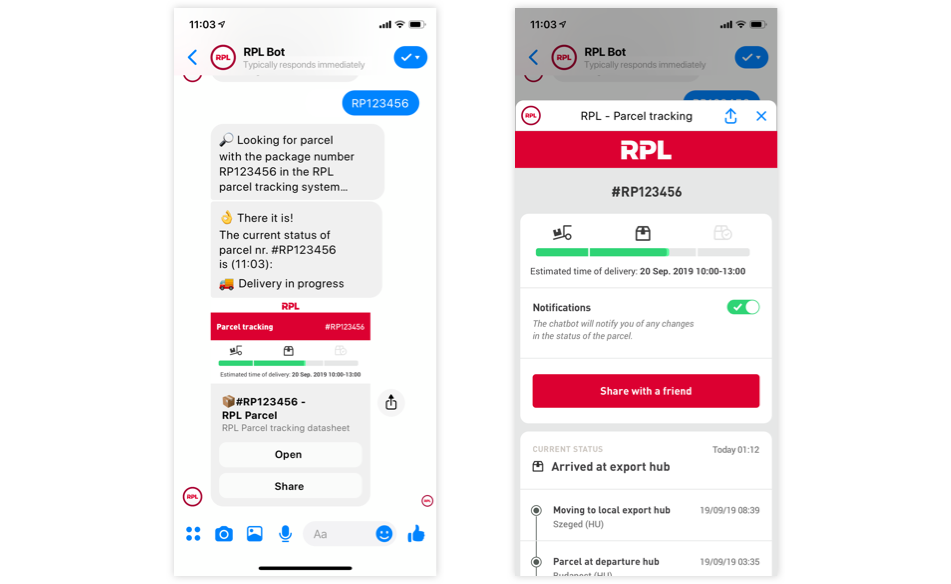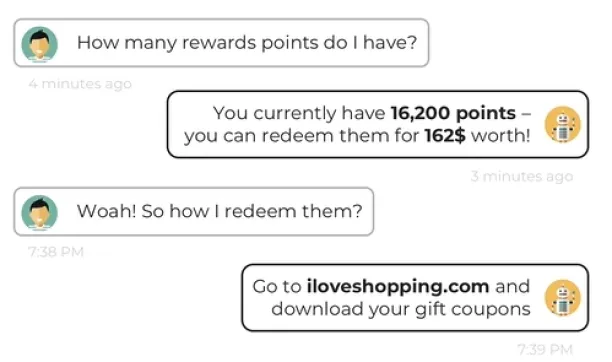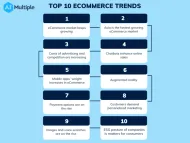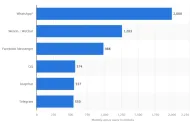Top 12 Use Cases & Examples of Retail Chatbots in 2024
Over 70% of chatbot conversations are expected to be with retail conversational AI systems in 2023. Additionally, in a survey, ±40% of U.S. consumers stated that they have used chatbots to engage with the retail industry. And as of 2020, ±54% of consumers had daily AI-enabled interactions with retail organizations.
Chatbots provide 24/7 support, answer FAQs, and can offer promotions to customers based on their intent, making them a great candidate for retailers to improve customer satisfaction and brand loyalty.
Top 12 chatbot use cases in retail
According to the National Retail Federation, 54% of shoppers go online to purchase something specific, and what makes them choose a specific brand to shop is:
- The ability to find what they want quickly and easily (58%).
- Quality customer service (44%).
- Speedy and simple checkouts (42%).
These features can all be embedded into the chatbots, making them excellent integrations with retail websites and communication platforms.
Sponsored:
Salesforce is the CRM market leader and Salesforce Contact Genie enables multi-channel live chat supported by AI-driven assistants. Salesforce Contact Center enables workflow automation for many branches of the CRM and especially for the customer service operations by leveraging chatbot and conversational AI technologies for a personalized customer experience.
Chatbot use cases in retail include:
1. Search for products
Throughout the conversation, and based on the customer’s preferences about the product, the chatbot can display a range of product options, such as the price range, features, and other user’s ranks and comments.
2. Recommendations
Recommendation engines integrated to chatbots can help retailers increase revenue and help users discover products that fit well with their tastes. Such adaptation of chatbots especially on messaging apps like WhatsApp is also called conversational commerce and enhanced customer satisfaction due to recommendations cause customers to spend more.
3. Locate nearby stores
A customer may want to see or try on a product that they found while browsing the website, in person. Via the chatbot, the customer can locate nearby stores, enquire about the product’s availability, and find out about opening hours.
4. Place orders and pre-orders
Customers can choose the product they want to purchase, set up their address and contact information, and place their order via the chatbot.
Additionally, the chatbot can provide information about upcoming products that are relevant to the customer’s preferences , and allow them to pre-order new products before they start shipping.
For example, an office supplies retail company, Staples, integrated IBM Watson’s chatbot to their Facebook messenger, Slack, and texting services. The chatbot allows customers to place orders for current and up-coming products from the Staples stores.
5. Track packages
Once the order is placed via the chatbot, the customer can ask about the whereabouts of the package, date and time of delivery, and information about the post service, such as their local branch’s contact information.

6. Customer education / FAQ
Instead of speaking to a live agent, the customer can get information from a chatbot about the product, such as the return policy of products, promotional campaigns, discounts coupons, and FAQs.
7. Support live agents
Chatbots are linked to the company’s database where all information about products, services, features, and locations exist. If customers prefer speaking to live agents, the agent can rely on the chatbot to quickly look up answers and prevent wrong information being communicated to customers.
8. Send personalized notifications
Chatbots typically ask users for their contact info during the conversation. This provides an opportunity for retailers to use the customers’ info to send users updates and notifications about new products, annual or seasonal sales, as well as branch openings and events.
These messages and notifications are based on a customer’s information, demographics, preferences, searches, and previous orders.
To find case studies regarding personalized notifications you can read our Top 5 Conversational Commerce Examples & Success Stories article.
9. Manage loyalty points
For retailers that provide customers with loyalty points, chatbots can ping the users and tell them about currently available points in their credit, and direct them to purchasing links or promotions where they can spend these points.

10. Manage complaints
The chatbot can register online complaints by asking about the incident details. The data and insights gathered through the chatbot for oversight and policy development purposes.
11. Collect customer feedback
Instead of reaching out to the customer to fill a satisfaction survey after a purchase, a chatbot can directly ask the customer questions, such as, ranking the product, the mail service, packaging, etc. in order to analyze consumer behavioral patterns and enhance the shopping experience.
12. Monitor use sentiment
NLP and affective AI technologies can analyze all customer conversations to infer their levels of satisfaction without asking them to fill surveys.
Integrating such technologies to chatbots enable a better customer experience. For example, they can help predict customers’ emotions. Some example use cases include:
- Enhance the customer’s experience or provide warnings when the user is in distress.
- Identify which recommendations derive delightful experiences for customers and try to replicate those experiences.
Other technologies for retail
Chatbots are one of many technologies which the retail industry can benefit from. Other eCommerce technologies include AI, RPA, intelligent automation, web crawling, and analytics which we’ve wrote in detail about. Combining these technologies will enable:
- Brand endorsement by customizing shopping experiences.
- Data and prediction-driven merchandize and promotions.
- Managing a higher volume of orders at the same time.
- Reduction of cost-to-serve:
- Chatbots can serve as helpers in self-service cashier stands.
- Analytics can offer predictions about customer service workload.
- Analytics can also offer estimations about in-store replenishment workload, such as shelving.
However, to reap the benefits of AI technologies, especially chatbots, a high level of training and testing is required to recognize the user’s intent and provide them with proper responses. Otherwise, chatbots may say unacceptable things, or simply not take no for an answer which could drive customers away from the brand. Feel free to read our articles about chatbot failures and A/B testing to avoid them.
For more on chatbots
For more applications of chatbots in different industries, feel free to read our articles:
- Top 9 Customer Service Chatbot Use cases/ Applications
- 5 Chatbot Applications / Use Cases in Marketing
- In-Depth Guide to B2B Chatbots: Use Cases & Examples
To learn more how AI is helping businesses today, feel free to read our article 100+ AI Use Cases & Applications: In-Depth Guide.
And if you are ready to invest in an off-the-shelf conversational AI product, we can help:
- Check out our data-driven list of chatbot platforms and voice bot vendors.
- Contact us to guide you through the process
This article was drafted by former AIMultiple industry analyst Alamira Jouman Hajjar.

Cem has been the principal analyst at AIMultiple since 2017. AIMultiple informs hundreds of thousands of businesses (as per similarWeb) including 60% of Fortune 500 every month.
Cem's work has been cited by leading global publications including Business Insider, Forbes, Washington Post, global firms like Deloitte, HPE, NGOs like World Economic Forum and supranational organizations like European Commission. You can see more reputable companies and media that referenced AIMultiple.
Throughout his career, Cem served as a tech consultant, tech buyer and tech entrepreneur. He advised businesses on their enterprise software, automation, cloud, AI / ML and other technology related decisions at McKinsey & Company and Altman Solon for more than a decade. He also published a McKinsey report on digitalization.
He led technology strategy and procurement of a telco while reporting to the CEO. He has also led commercial growth of deep tech company Hypatos that reached a 7 digit annual recurring revenue and a 9 digit valuation from 0 within 2 years. Cem's work in Hypatos was covered by leading technology publications like TechCrunch and Business Insider.
Cem regularly speaks at international technology conferences. He graduated from Bogazici University as a computer engineer and holds an MBA from Columbia Business School.
To stay up-to-date on B2B tech & accelerate your enterprise:
Follow onNext to Read
E-commerce Analytics in 2024: 5 Benefits & Methods
Top 5 WhatsApp Business Partners in 2024
Top 16 Retail Workload Automation Benefits in 2024
The stats is impressive. I really don’t understand business owners and web masters who still ignore chatbots. Site visitors (and potential clients) want to get all the necessary info as soon as possible, and auto messaging tools can help them in the quickest and most efficient way. I installed a smart chatbot and the lead generation stats has grown up to 48%. If you still don’t use a chatbot for your business, you simply lose potential customers and profits.
Hi Nathan. We’re glad you enjoyed the article. For more chatbot stats, read this article: https://research.aimultiple.com/chatbot-stats/


Comments
Your email address will not be published. All fields are required.